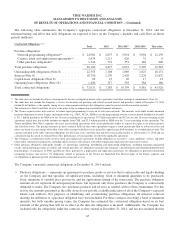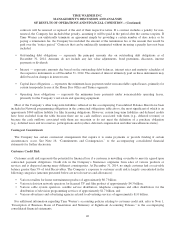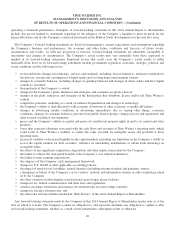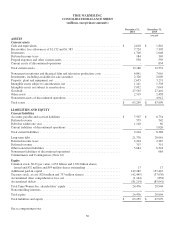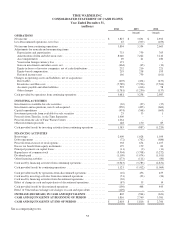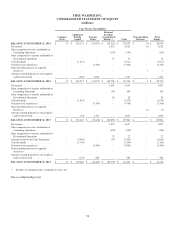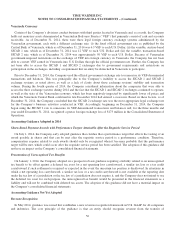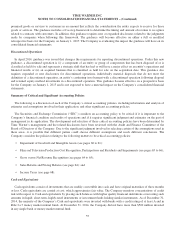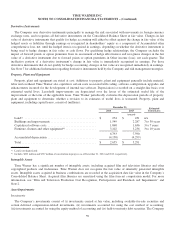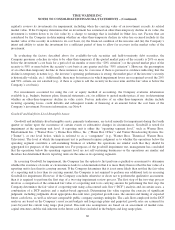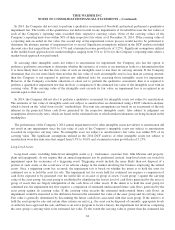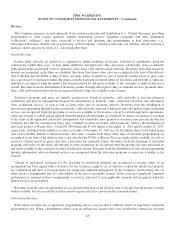Time Magazine 2014 Annual Report Download - page 71
Download and view the complete annual report
Please find page 71 of the 2014 Time Magazine annual report below. You can navigate through the pages in the report by either clicking on the pages listed below, or by using the keyword search tool below to find specific information within the annual report.TIME WARNER INC.
NOTES TO CONSOLIDATED FINANCIAL STATEMENTS
1. DESCRIPTION OF BUSINESS, BASIS OF PRESENTATION AND SUMMARY OF SIGNIFICANT
ACCOUNTING POLICIES
Description of Business
Time Warner Inc. (“Time Warner” or the “Company”) is a leading media and entertainment company, whose businesses
include television networks, and film and TV entertainment. Time Warner classifies its operations into three reportable
segments: Turner: consisting principally of cable networks and digital media properties; Home Box Office: consisting
principally of premium pay television services domestically and premium pay and basic tier television services
internationally; and Warner Bros.: consisting principally of television, feature film, home video and videogame production
and distribution.
Separation of Time Inc.
On June 6, 2014 (the “Distribution Date”), the Company completed the legal and structural separation of the Company’s
Time Inc. segment from the Company (the “Time Separation”). The Time Separation was effected as a pro rata dividend of
all shares of Time Inc. common stock held by Time Warner in a spin-off to Time Warner stockholders. With the completion
of the Time Separation, the Company disposed of the Time Inc. segment in its entirety and ceased to consolidate its assets,
liabilities and results of operations in the Company’s consolidated financial statements. Accordingly, the Company has recast
its financial information to present the financial position and results of operations of its former Time Inc. segment as
discontinued operations in the consolidated financial statements for all periods presented. For a summary of discontinued
operations, see Note 3.
In connection with the Time Separation, the Company received $1.4 billion from Time Inc., consisting of proceeds
relating to Time Inc.’s acquisition of the IPC publishing business in the U.K. from a wholly-owned subsidiary of Time
Warner and a special dividend.
Basis of Presentation
Basis of Consolidation
The consolidated financial statements include all of the assets, liabilities, revenues, expenses and cash flows of entities in
which Time Warner has a controlling interest (“subsidiaries”). Intercompany accounts and transactions between consolidated
entities have been eliminated in consolidation.
Changes in Basis of Presentation
The 2013 and 2012 financial information has been recast so that the basis of presentation is consistent with that of the
2014 financial information. This recast reflects the financial position and results of operations of the Company’s former Time
Inc. segment as discontinued operations for all periods presented.
Use of Estimates
The preparation of financial statements in conformity with U.S. generally accepted accounting principles (“U.S. GAAP”)
requires management to make estimates, judgments and assumptions that affect the amounts reported in the consolidated
financial statements and footnotes thereto. Actual results could differ from those estimates.
Significant estimates and judgments inherent in the preparation of the consolidated financial statements include
accounting for asset impairments, multiple-element transactions, allowances for doubtful accounts, depreciation and
amortization, the determination of ultimate revenues as it relates to amortization of capitalized film and programming costs
and participations and residuals, home video and videogames product returns, business combinations, pension and other
postretirement benefits, equity-based compensation, income taxes, contingencies, litigation matters, reporting revenue for
certain transactions on a gross versus net basis, and the determination of whether the Company should consolidate certain
entities.
55


